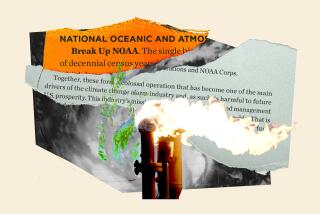Polar bear status pits environmentalists vs. administration
- Share via
Reporting from Washington — A dispute about how much the government should protect polar bears has turned into a battleground for environmentalists and some of the country’s most powerful business organizations over the larger question of global warming.
On Wednesday, the Interior Department filed arguments in federal court defending its decision to classify polar bears as “threatened” rather than “endangered” despite widespread shrinkage of the sea ice that forms the bears’ natural habitat.
What makes the issue so sensitive is that, if polar bears received the stricter endangered classification, the Obama administration would be pressured to attack the problem at its source: the petroleum, coal and manufacturing companies that emit the greenhouse gases scientists say are a major factor in climate change.
“There is a pronounced push-back from industry because they rightly see that they will have to modify or mitigate their activities to comply with the laws,” said Andrew Wetzler, director of the Land and Wildlife program at the Natural Resources Defense Council, one of the environmental groups suing to change the polar bear’s status.
In early 2009, the Obama administration pledged to revisit several controversial environmental decisions made under George W. Bush — including the polar bear’s status. But months later, Obama’s Interior Department ratified the bears’ “threatened” classification.
Although the Obama administration has moved steadily to reduce greenhouse gas emissions — with a tough reelection campaign ahead in 2012 and a still-wobbly economy — the White House has been trying not to provoke policy battles with the wary business community.
The issue is even more sensitive because tougher emissions rules would be likely to raise prices and could cost jobs.
Scientific data point to a mounting threat to the polar bear, the largest carnivore on land. Typically, polar bears hunt for ringed seals on the sea ice, catching them when they come up for air.
But higher temperatures have brought about a rapid decline in summer sea ice, robbing bears of their hunting platforms. The loss of sea ice essentially threatens bears with starvation.
The International Union for Conservation of Nature considers the species “decreasing.” A recent paper in the journal Ecology concluded there was a “high probability” that polar bears would disappear in the Beaufort Sea, which is off Alaska, by the end of the century.
The Interior Department does not dispute the science, which it uses as the basis of its “threatened” listing. But the listing contains the so-called “4d” exemption, excluding greenhouse gases from being regulated as a threat to a species.
Industry groups, including the American Petroleum Institute, the U.S. Chamber of Commerce and the National Mining Assn., are fighting to keep the exemption.
“It’s based upon the position that the science doesn’t exist to draw a link between a particular activity, industrial or otherwise, and an identifiable incremental effect on sea ice,” said Richard Ranger, senior policy advisor for API.
“Given the inability to establish a causal relationship between, say, expansion of the port of Los Angeles to sea-ice loss, why should U.S. industries be subject to additional burdens when Chinese industries are not subject to anything?” he said.
But lawyers for the environmental groups would like to win endangered status for the polar bear precisely because the listing would eliminate the 4d exemption.
Kassie R. Siegel, director of the Center for Biological Diversity’s Climate Law Institute and the lead attorney in the environmental groups’ petition to change the bear’s status, denounced the government’s action and said her group would mount a new legal challenge.
“The new decision from the Obama administration amounts to nothing more than lipstick on a pig,” she said. “It puts a gloss on a horribly flawed Bush-era decision that is anti-science and serves to greatly undermine the protection of not just the polar bear but all of America’s imperiled wildlife.”
Still, some independent legal and scientific experts say the Endangered Species Act may not be an appropriate tool to deal with the impact of climate change, designed, as it was, to regulate humans encroaching on forests or polluting rivers.
“It just screams for some kind of response from Congress and not the courts,” said J.B. Ruhl, law professor at Florida State University College of Law and a specialist in endangered species protection. “But in Congress you have a stalemate.”
More to Read
Sign up for Essential California
The most important California stories and recommendations in your inbox every morning.
You may occasionally receive promotional content from the Los Angeles Times.











